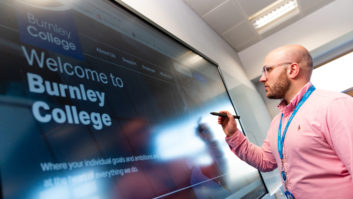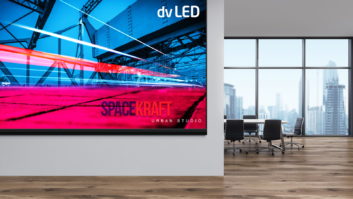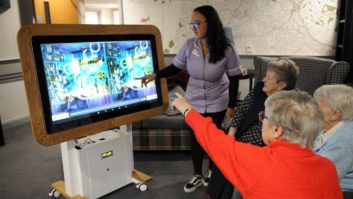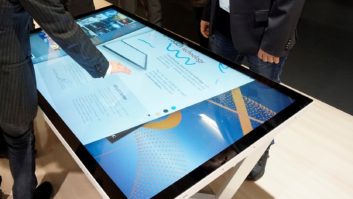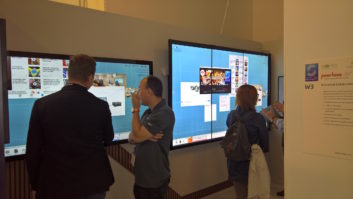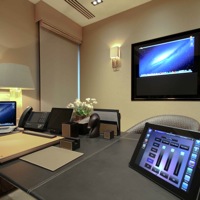
The ever-growing use of personal touchscreen devices is being embraced by the AV industry as tablets simplify room control for both commercial and residential clients, writes Steve Montgomery.
Among the many uses of personal devices is the ability to control and manipulate room environments and audiovisual equipment through the now familiar touchscreen interface. This brings personal control to the user’s own device or to a tablet dedicated to the room, in conjunction with, or as an alternative to, the traditional control interface. Tablets and smartphones with touch-sensitive screens have dramatically altered users’ perception of interaction with computers, mobile phones and personal devices. This is having a knock-on effect in the commercial and business worlds on several fronts, including environmental and AV equipment control.
“The world has embraced the gesture-based user interface. Products like the iPhone and iPad forever changed the wireless mobility market and have helped to drive the demand for a similar experience in the control and automation markets,” notes Jonathan Mangnall, sales director, AMX Europe. “The huge popularity of these smart-enabled devices demonstrates the extent to which gesture-based multitouch products can help simplify the interaction between people and the technology around them. As a result, we are experiencing an explosion of interest in the dedicated touchpanel control interface, with users seeking an intuitive interaction similar to their wireless consumer products.”
In the domestic environment, where individuals generally have their own smart device, it is now common practice for each user to have a personal point of control that moves around the living space with them. Manufacturers of control systems have, for some time, offered applications that provide these services within homes and these are now entering the commercial market in larger numbers, as Ronald Gelten, director of business development for retail and hospitality at Philips Dynalite, explains: “Smart devices and control apps are a perfect example of how technology increases comfort, offers raised levels of flexibility and can increase productivity. It is a very appealing combination which has brought about a shift in people’s expectations towards technology; they are coming to expect that they can personalise their environment with these devices, no matter where they are. This includes setting light levels and atmospheres in various situations; within their office space or hotel room just as they do in their home.”
Lutron, another lighting control manufacturer, has introduced similar tools. “To give additional flexibility to the user we introduced iPhone and iPad apps for our HomeWorks residential system in 2011 and our Quantum commercial app last year,” says Guy Simmonds, UK sales director. “Since then we have noticed that a significant amount of our clients choose to have the app control option alongside more traditional control forms, giving them global control of their lighting.”
Personal touch
In response to the change in user interfaces brought about by personal devices, automation system manufacturers have redesigned their products to present a more modern face and to respond more like a tablet than the traditional button-centric touch controller. Crestron’s in-wall panels now have edge-to-edge glass capacitive touchscreens, which, as Phillip Pini, systems design engineer Crestron UK, explains, “replaces the passive inlay and provides a user-friendly touch interface more like a tablet in operation while operating with Crestron automation systems”.
This approach is followed by AMX too. Mangnall says: “With a projected capacitive touch display, the Modero X offers multitouch capabilities which, when combined with gestures, can support a number of intuitive human interactions such as taps, drags, swipes, flicks and twists. The Modero X Series then integrates these gestures into a complete control product.”
The original fear of control system manufacturers – particularly those that manufactured prestige touch control panels – that the emergence of a lower-cost, general-purpose tablet would kill their markets has largely been unfounded. “While we initially anticipated that the low price point of the iPad and iPad mini would significantly erode the market for higher priced touchscreens, it hasn’t completely eliminated the need for fixed touchscreens,” says Jeremy Scheinberg, COO at Alcorn McBride. “The lack of a wired Ethernet connection has been a deal-breaker in some instances. It would be great to have a wired option for the iPad as well to open up new markets.”
Personal devices are often used as complementary controllers in commercial applications, used alongside traditional controllers and interfacing with the same automation system. Control4 has experience of several installations of this type, as Paul Williams, VP of security and communications products, explains: “A good example of complementary operation is in a sports bar or restaurant location, where it is often convenient for staff to use a mobile device to alter limited aspects of the environment; lights, temperature, music and video content as a subset of the whole system. Another is where a visitor may use their own device to have limited control of a presentation room.”
A further area of benefit is where it can be desirable to have a mobile operator or maintenance interface to the main system. As an operator interface, it provides presenter mobility and allows them to address an audience in a more normal way without being confined to an installed interface. As a maintenance interface, a wireless device can allow personnel to check individual devices – including projectors, lighting and audio amplifiers – without having to run unnecessary systems, have a second technician working with them or forcing them to return to the main equipment rack to adjust individual devices.
The complementary configuration is driven largely by the desire to centralise the control functionality within a control system rather than within the mobile device for security and reliability reasons. If the tablet is lost or even if the battery runs down, a replacement unit can simply and quickly connect to the wireless system, retrieve the necessary files automatically and become a replacement interface without interruption to the overall system.
Changing market
While the main automation system manufacturers have embraced the arrival of smart devices by creating their own apps, some companies do see the personal device as the main control interface and have ceased production of their own controllers. Instead they are focusing on software platforms and application tools for tablets and smartphones.“The market for proprietary touchpanels has greatly diminished. As a consequence Savant ceased production of its own touchpanels to control its range of switching devices and controllers as soon as the iPad became available, at the same time making the control apps free to encourage users to connect their own devices,” explains David Webster, CTO for distributor RGB Communications. “The presumption is that this will be the lowest-cost solution and that the end user is now expecting it. For many users who organise their entire digital life with a tablet device, controlling AV facilities in a room is second nature and so it will be a primary method of interaction for them.”
A significant factor that has enabled the use of tablets in commercial installations is the ability to lock an operation down to prevent a user switching to another, unauthorised one. This has been possible for some time with Windows-based devices and was introduced in Apple iOS6 as Guided Access mode. Prior to this, there was no way to lock out the home button to prevent users from escaping the desired application and switching to something else.
Applications have been developed that provide limited access to parts of systems, for example in providing control of lighting in the immediate area or in controlling just the projector inputs, lighting and sound level in an auditorium, but preventing access to other system level configuration points. In many cases the dedicated application is combined with presentation software to provide an integrated and complete user-friendly presentation system.
Control and interface applications can be easily and economically written for all main operating system platforms deployed on tablets and smartphones, with programming teams available on a wider scale than those specialising in more traditional control software. Applications can often be modified and downloaded remotely, negating the need for site visits and further reducing the cost of implementation. Those for Android and Windows platforms can be distributed directly by the manufacturer while those for Apple devices can only be deployed and delivered through the iTunes store after approval and testing by Apple.
Despite the delay in releasing applications caused by this process it is generally not seen as a disadvantage and can actually provide benefits, in version control, updates and the ability for external developers to write apps. Jeremy Scheinberg points out another advantage: “Since many of the installations we have been discussing are reliant on wireless networking and complicated always-on communications, it is important to be able to test the application thoroughly.”
Web control
An alternative technique is that offered by web-based control coupled with network delivery and potentially Cloud services. Applications that use a web browser interface extend the control surface beyond the local vicinity to enable users to manage settings from a distance. In domestic situations it means that heating and lighting can be adjusted from an office desk before a homeowner returns for the evening. In commercial environments it enables facility management from afar.
Gelten says: “We offer a range of applications and user interfaces, and depending on the target segment, they are based on a web interface or app. For example, if the interface to a certain installation is accessed by several people who may have different access rights, we usually work via web interface. This is useful in networked lighting installations in multi-tenant buildings where each user gets access to only a portion of the lighting network. Another example is multi-site controls in which users at headquarter levels get access to different cross-sections of remote locations.”
The Web Server feature for HRS Control’s UDC Software allows virtual controllers to be displayed on any device capable of internet connectivity and through a web browser, including all tablets and smartphones, as well as Windows devices, PCs and Mac computers. A powerful feature of this approach is that user interfaces can be generated simply by the user without complex programming; either from pre-prepared system command sets, or user-defined custom sets and through the use of a structured software package. The versatility and quick programming of the UDC software makes it an ideal solution for live events although it is also finding favour in fixed installations.
Pini has also identified the need to provide web-based links that interface to Crestron controllers: “Using HTML5 to develop a web version of a touchpanel is a powerful feature enabling any personal device or computer to be used. It also extends the scope of the system to other, less common devices such as smartboards and large touchpanels so that they can be used as controllers too, without needing dedicated applications. Embedded PC applications such as media players and video streaming means that these features can be incorporated into the complete solution alongside network access to other computers and sources.”
Personal devices definitely have a role in domestic and commercial control, which is already well covered by the traditional manufacturers of automation systems as well as newer, dedicated companies. As the world becomes ever more reliant on personal devices and they encroach even further into our daily lives, this can only be set to increase.
www.alcorn.com
www.amx.com
www.control4.com
www.crestron.com
www.hrscontrol.com
www.lutron.com
www.philips.com/dynalite
www.rgbcomms.co.uk
www.savantsystems.com
